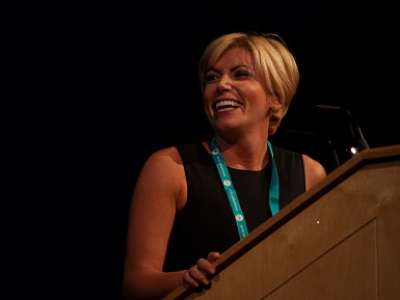
The PMG Conference 2018 was a brand-new experience for me, having only recently graduated from university and entered the real world of work as a trainee rehabilitation engineer with the Posture and Mobility Service in Birmingham. The event was an opportunity to meet companies, researchers and other clinicians from around the country, and to learn from their experiences. At first, the scale of the conference was quite daunting, with huge numbers of people, the large exhibition hall, and so many stands; however I was soon put at ease by other attendees, and by the exhibitors who were keen to explain their products and innovations to a new audience.
Aside from the exhibition, I was also keen to attend the plenary sessions to hear about research that is outside the remit of my day-to-day work, but may have an impact on wheelchair provision for many individuals. One of these was Selective dorsal rhizotomy (SDR), by Benedetta Pettorini, a consultant from Alder Hey Children’s Hospital in Liverpool. As I work within a busy wheelchair service where many patients have spasticity, SDR could have an impact on the treatment of these patients and their future mobility needs.
Benedetta presented her recent research, covering the process of SDR, the ideal candidate for the procedure, and the pros and cons. An area that she was keen to discuss was the management of expectations of both the patient and of the family. Common questions that she faces pre-treatment include: “Will SDR cure cerebral palsy (CP)?” and “Will my child be able to walk after SDR?”
One fact I didn’t know before attending this presentation was that the NHS had stopped providing funding for SDR procedures three years ago, stating that they required more outcome measures and accurate results. Benedetta was extremely pleased to announce that they had just been informed that funding would now be available again.
Currently spasticity can be managed in several ways: most commonly with a Baclofen pump; selective peripheral denervation; or SDR. The SDR procedure is irreversible and, as such, the benefits and potential improvements must be considered before the procedure is carried out to ensure that it is in a patient’s best interests. Benedetta stated that when considering SDR as a treatment, pain is used as one of the essential criteria, as well as improving function (e.g. walking), and facilitating good patient care (dressing, transfers and sitting).
An ideal candidate to consider for SDR would be an individual who falls into the following categories:
- GMFCS II-III. Some sitting ability and some mobility with or without assistance
- Muscle strength. Able to maintain anti-gravity posture
- Minimal muscle/soft tissue contractures
- Good cognitive/psychological maturity (co-operative)
- Good family support network
Each case is reviewed on an individual basis with emphasis on long-term need and realistic likelihood of improvement. SDR is generally considered for CP patients; however, it is possible for it to have a positive effect on individuals following a traumatic brain injury where spasticity is present.
Benedetta was keen to stress that SDR is not a procedure suitable for everyone with spasticity, and that realistic goals must be set to ensure a patient and their family are not expecting the procedure to be a miracle cure. They will be asked to be open about their goals pre-operation to ensure their expectations can be managed. A pre-operative baclofen test and gait analysis may be done when expectations are unrealistic. This allows Benedetta and her team to gain a snapshot of what a patient may be like straight after the SDR procedure, and to enable parents to see what improvements can be expected.
During an SDR procedure the sensory dorsal nerve roots are severed whilst the patient is lying in the prone position. The nerves are tested to ensure they are the sensory nerves as there is a small risk of cutting motor nerve roots. The SDR procedure also carries risk, for example, worsening motor function, paraplegia, scoliosis and bladder leak. As well as the risks there are pros and cons to the procedure that families are made aware of:
| Pros | Cons |
|
|
The results of Benedetta and her team’s work show some real positives in spasticity management. It was found that the level of spasticity removed varies according to GMFCS level, because patients begin at different levels of ability. Patients experienced decreased spasticity, increased strength, increased mobility, and an overall persistent improvement over 10 years of the study. Improvements were also seen in speech patterns, oropharyngeal control, fine motor control, and cognition. Again, these improvements were dependent on the individual and their abilities pre-procedure. A challenge for Benedetta and her team is the lack of an ideal outcome measure for SDR treatment.
Having never heard of SDR before attending PMG, I was fascinated to learn of its success and the improvements that patients have achieved. The procedure can be used not only for those with some mobility, but also for those unable to walk, to provide them with better seated posture. This would be of benefit to the patient as well as the wheelchair service clinical team because spasticity can be challenging for wheelchair provision. Benedetta is keen to promote SDR, and stated that if clinicians are unsure of suitability then they can refer their patients, and a decision will be made by the surgical team.
I would like to thank Benedetta for taking the time to present at the conference, and for continuing to work in such a challenging area which could help provide improved outcomes for many wheelchair users and their providers. I am also extremely grateful to have been given the opportunity to attend PMG 2018 as a bursar and, as I start my career, for the chance it gave me to further my knowledge.
Photograph is of Benedetta Pettorini presenting at PMG Conference 2018
Photographer Jonathan Rourke






.jpg)



no comments
Add your comment...